Impact of EIP Programs on Child Development: A Comparative Analysis
VerifiedAdded on 2023/01/18
|23
|7614
|61
Report
AI Summary
This report provides a critical analysis of two early intervention and prevention (EIP) projects, examining their impact on children, families, and communities, particularly those affected by poverty. The research paper explores the association between childcare quality and early academic skills, emphasizing the importance of early intervention. The practice project involves a field survey of the School as Community Centre Program. The report identifies vulnerabilities influencing child development, analyzes the projects using the TEAM-ECD framework, and evaluates their support for families and children. It compares the effectiveness, strengths, and limitations of each project, considering how they engage 'hard-to-reach' families and address community diversity. The study highlights the importance of ECEC programs, parenting groups, and government policies in promoting child well-being and reducing literacy gaps. The report concludes by comparing the strengths and weaknesses of each project, considering data limitations and engagement strategies.

Paraphrase This Document
Need a fresh take? Get an instant paraphrase of this document with our AI Paraphraser
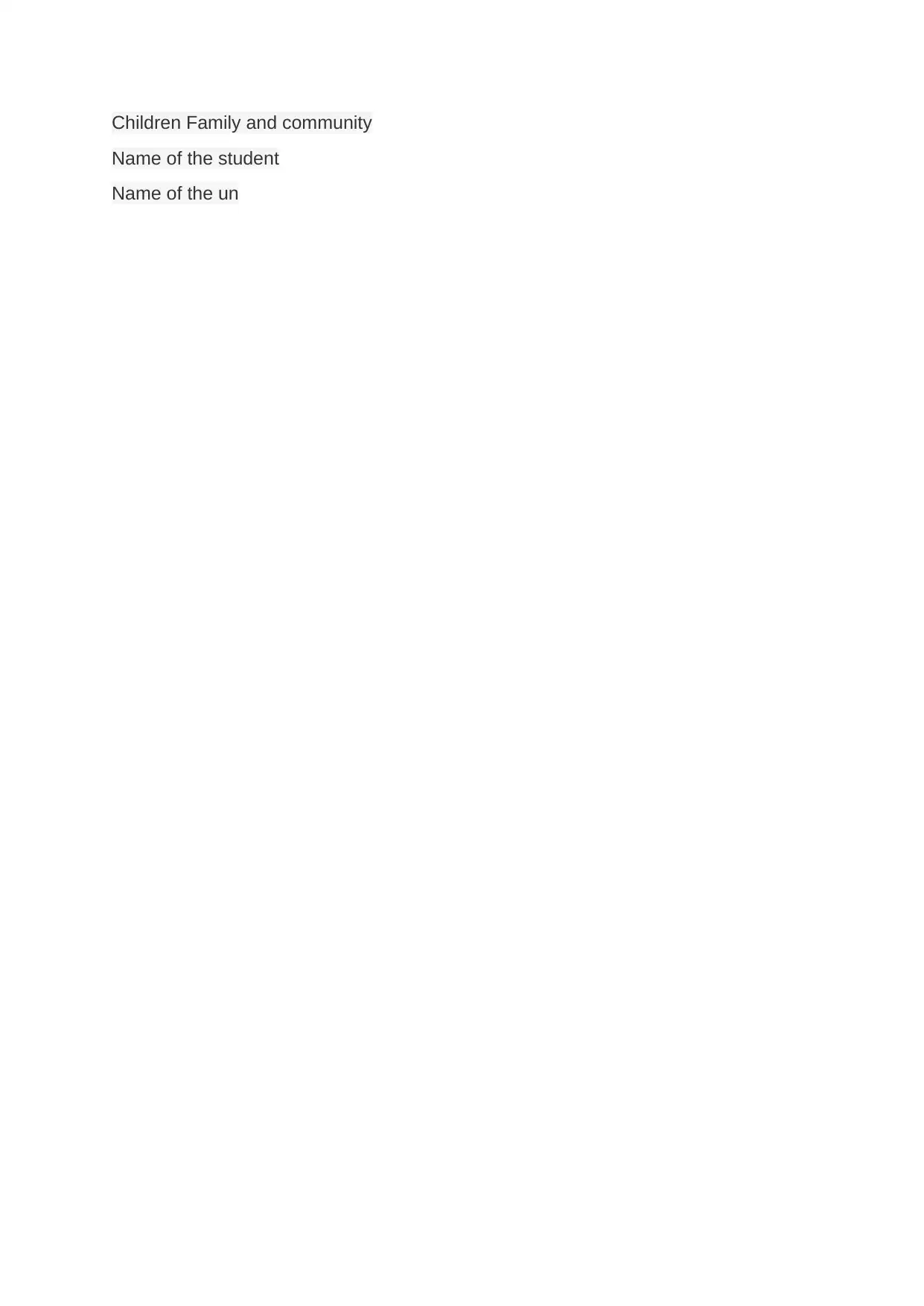
Children Family and community
Name of the student
Name of the un
Name of the student
Name of the un
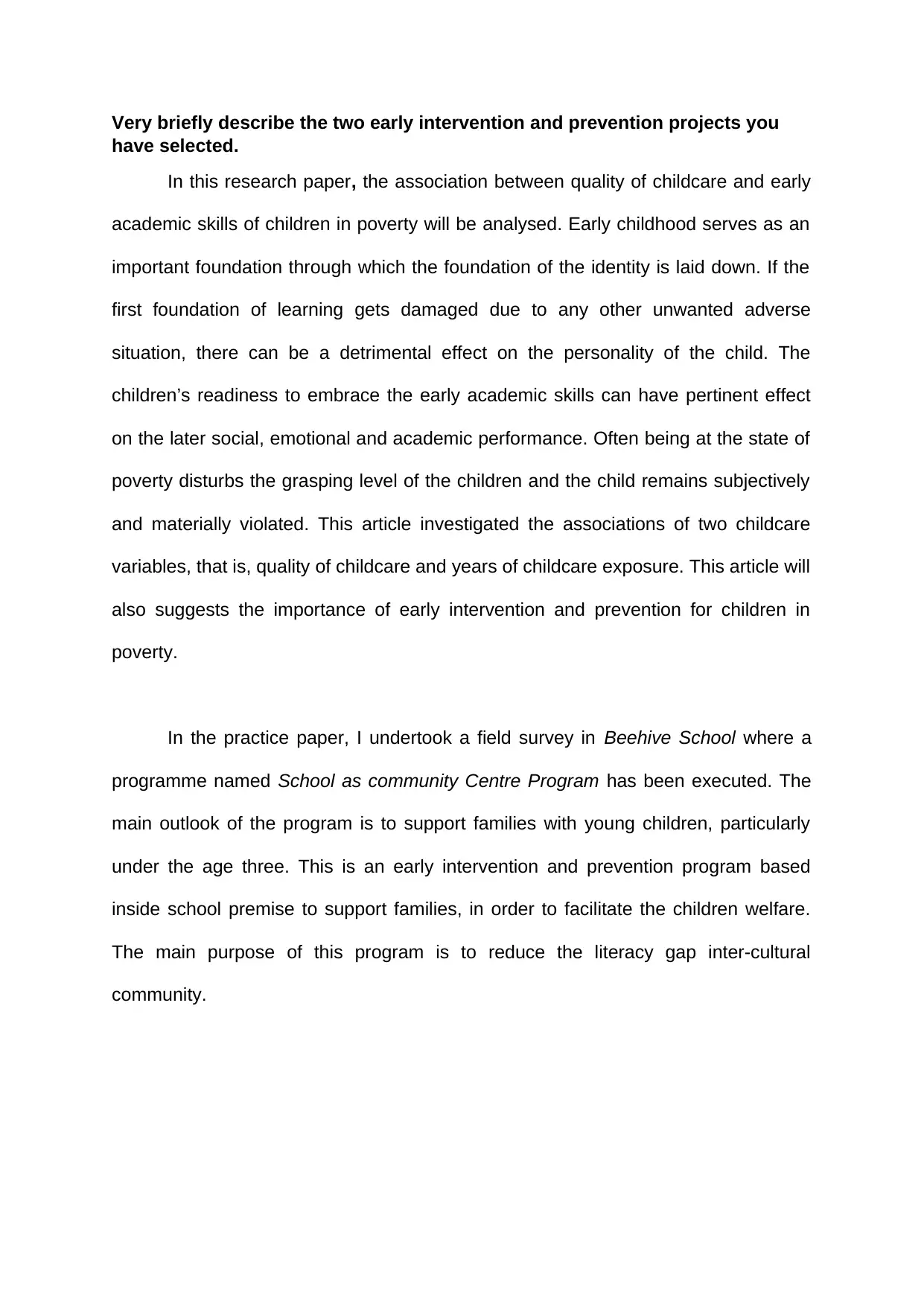
Very briefly describe the two early intervention and prevention projects you
have selected.
In this research paper, the association between quality of childcare and early
academic skills of children in poverty will be analysed. Early childhood serves as an
important foundation through which the foundation of the identity is laid down. If the
first foundation of learning gets damaged due to any other unwanted adverse
situation, there can be a detrimental effect on the personality of the child. The
children’s readiness to embrace the early academic skills can have pertinent effect
on the later social, emotional and academic performance. Often being at the state of
poverty disturbs the grasping level of the children and the child remains subjectively
and materially violated. This article investigated the associations of two childcare
variables, that is, quality of childcare and years of childcare exposure. This article will
also suggests the importance of early intervention and prevention for children in
poverty.
In the practice paper, I undertook a field survey in Beehive School where a
programme named School as community Centre Program has been executed. The
main outlook of the program is to support families with young children, particularly
under the age three. This is an early intervention and prevention program based
inside school premise to support families, in order to facilitate the children welfare.
The main purpose of this program is to reduce the literacy gap inter-cultural
community.
have selected.
In this research paper, the association between quality of childcare and early
academic skills of children in poverty will be analysed. Early childhood serves as an
important foundation through which the foundation of the identity is laid down. If the
first foundation of learning gets damaged due to any other unwanted adverse
situation, there can be a detrimental effect on the personality of the child. The
children’s readiness to embrace the early academic skills can have pertinent effect
on the later social, emotional and academic performance. Often being at the state of
poverty disturbs the grasping level of the children and the child remains subjectively
and materially violated. This article investigated the associations of two childcare
variables, that is, quality of childcare and years of childcare exposure. This article will
also suggests the importance of early intervention and prevention for children in
poverty.
In the practice paper, I undertook a field survey in Beehive School where a
programme named School as community Centre Program has been executed. The
main outlook of the program is to support families with young children, particularly
under the age three. This is an early intervention and prevention program based
inside school premise to support families, in order to facilitate the children welfare.
The main purpose of this program is to reduce the literacy gap inter-cultural
community.
⊘ This is a preview!⊘
Do you want full access?
Subscribe today to unlock all pages.

Trusted by 1+ million students worldwide
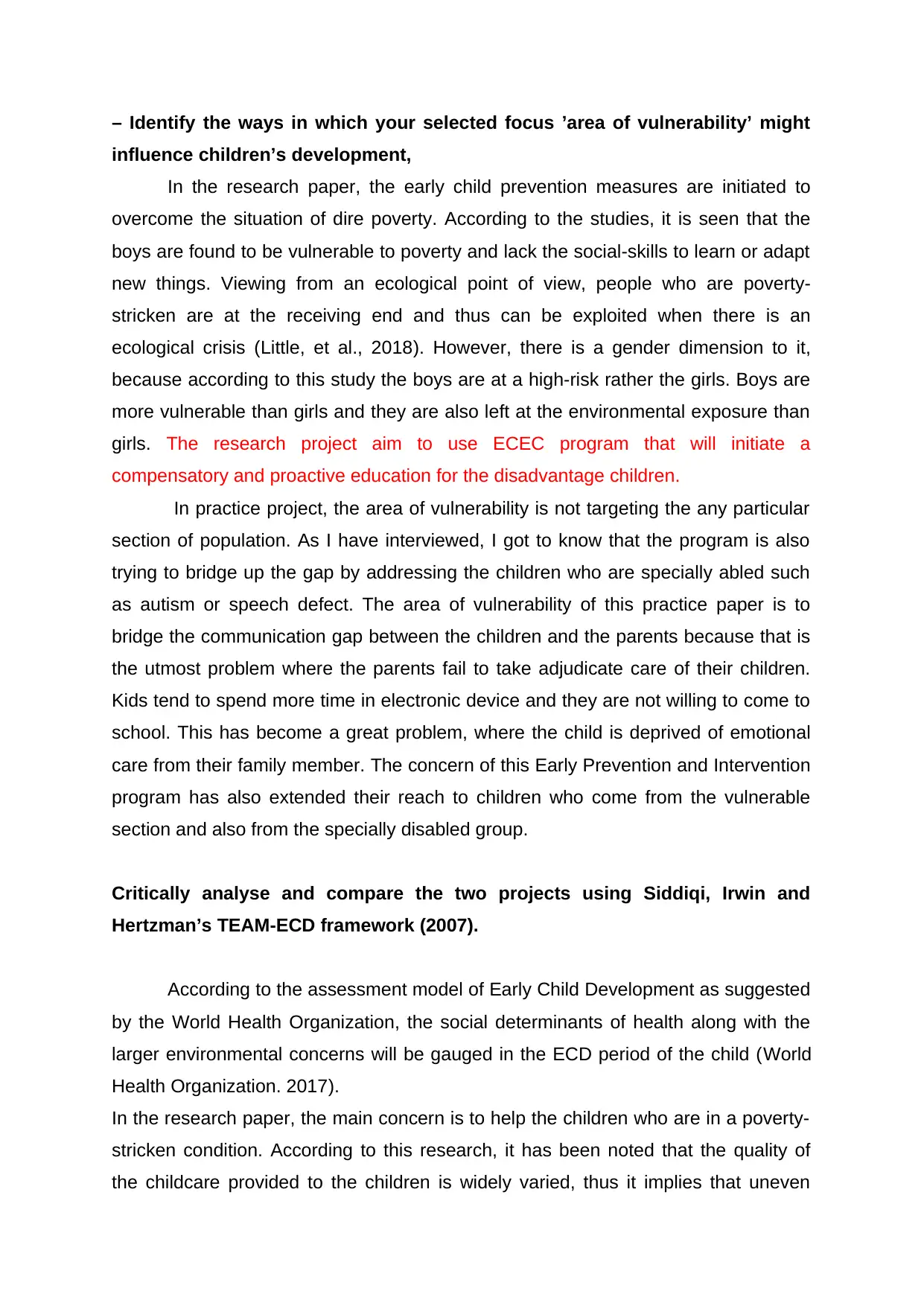
– Identify the ways in which your selected focus ’area of vulnerability’ might
influence children’s development,
In the research paper, the early child prevention measures are initiated to
overcome the situation of dire poverty. According to the studies, it is seen that the
boys are found to be vulnerable to poverty and lack the social-skills to learn or adapt
new things. Viewing from an ecological point of view, people who are poverty-
stricken are at the receiving end and thus can be exploited when there is an
ecological crisis (Little, et al., 2018). However, there is a gender dimension to it,
because according to this study the boys are at a high-risk rather the girls. Boys are
more vulnerable than girls and they are also left at the environmental exposure than
girls. The research project aim to use ECEC program that will initiate a
compensatory and proactive education for the disadvantage children.
In practice project, the area of vulnerability is not targeting the any particular
section of population. As I have interviewed, I got to know that the program is also
trying to bridge up the gap by addressing the children who are specially abled such
as autism or speech defect. The area of vulnerability of this practice paper is to
bridge the communication gap between the children and the parents because that is
the utmost problem where the parents fail to take adjudicate care of their children.
Kids tend to spend more time in electronic device and they are not willing to come to
school. This has become a great problem, where the child is deprived of emotional
care from their family member. The concern of this Early Prevention and Intervention
program has also extended their reach to children who come from the vulnerable
section and also from the specially disabled group.
Critically analyse and compare the two projects using Siddiqi, Irwin and
Hertzman’s TEAM-ECD framework (2007).
According to the assessment model of Early Child Development as suggested
by the World Health Organization, the social determinants of health along with the
larger environmental concerns will be gauged in the ECD period of the child (World
Health Organization. 2017).
In the research paper, the main concern is to help the children who are in a poverty-
stricken condition. According to this research, it has been noted that the quality of
the childcare provided to the children is widely varied, thus it implies that uneven
influence children’s development,
In the research paper, the early child prevention measures are initiated to
overcome the situation of dire poverty. According to the studies, it is seen that the
boys are found to be vulnerable to poverty and lack the social-skills to learn or adapt
new things. Viewing from an ecological point of view, people who are poverty-
stricken are at the receiving end and thus can be exploited when there is an
ecological crisis (Little, et al., 2018). However, there is a gender dimension to it,
because according to this study the boys are at a high-risk rather the girls. Boys are
more vulnerable than girls and they are also left at the environmental exposure than
girls. The research project aim to use ECEC program that will initiate a
compensatory and proactive education for the disadvantage children.
In practice project, the area of vulnerability is not targeting the any particular
section of population. As I have interviewed, I got to know that the program is also
trying to bridge up the gap by addressing the children who are specially abled such
as autism or speech defect. The area of vulnerability of this practice paper is to
bridge the communication gap between the children and the parents because that is
the utmost problem where the parents fail to take adjudicate care of their children.
Kids tend to spend more time in electronic device and they are not willing to come to
school. This has become a great problem, where the child is deprived of emotional
care from their family member. The concern of this Early Prevention and Intervention
program has also extended their reach to children who come from the vulnerable
section and also from the specially disabled group.
Critically analyse and compare the two projects using Siddiqi, Irwin and
Hertzman’s TEAM-ECD framework (2007).
According to the assessment model of Early Child Development as suggested
by the World Health Organization, the social determinants of health along with the
larger environmental concerns will be gauged in the ECD period of the child (World
Health Organization. 2017).
In the research paper, the main concern is to help the children who are in a poverty-
stricken condition. According to this research, it has been noted that the quality of
the childcare provided to the children is widely varied, thus it implies that uneven
Paraphrase This Document
Need a fresh take? Get an instant paraphrase of this document with our AI Paraphraser
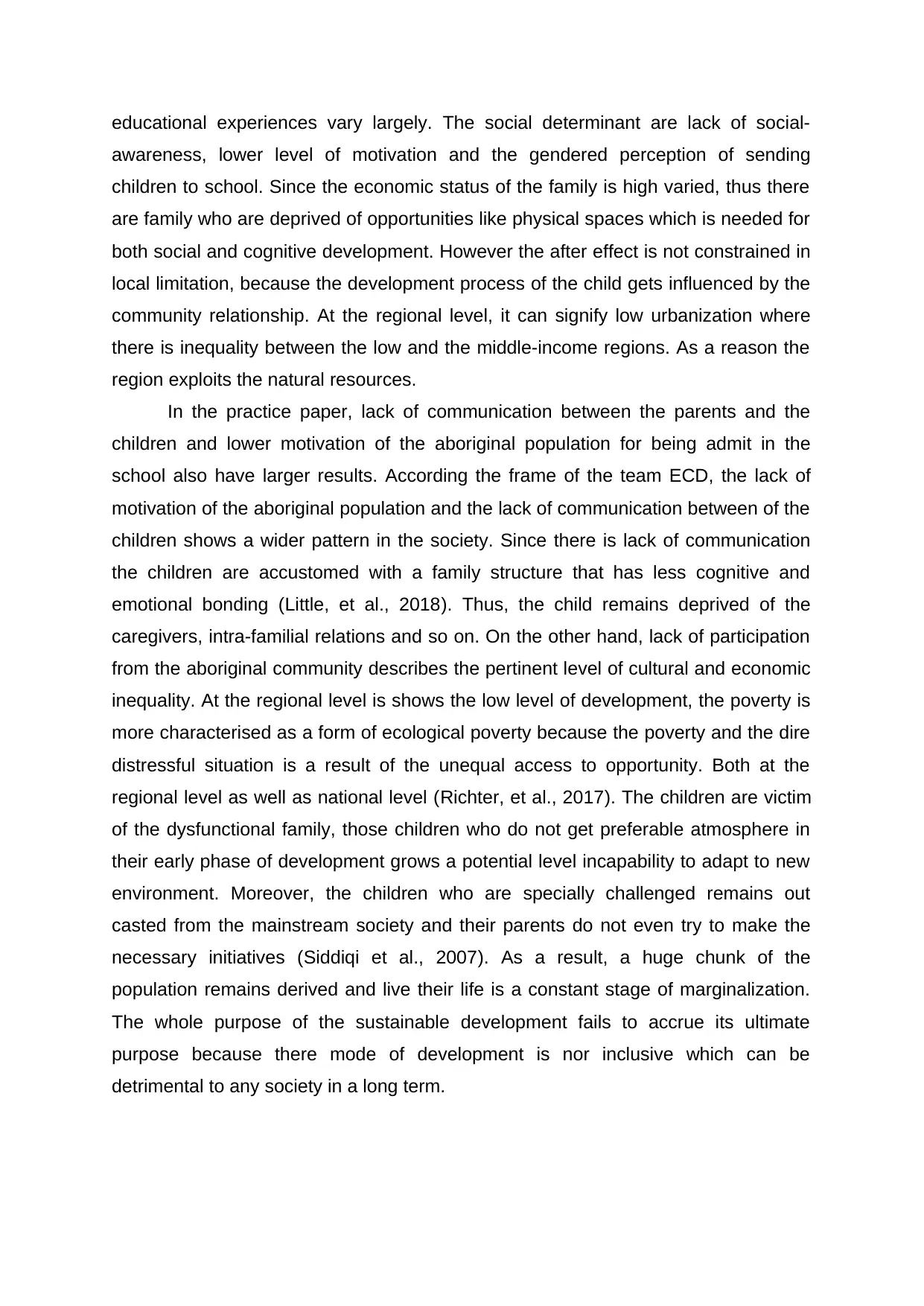
educational experiences vary largely. The social determinant are lack of social-
awareness, lower level of motivation and the gendered perception of sending
children to school. Since the economic status of the family is high varied, thus there
are family who are deprived of opportunities like physical spaces which is needed for
both social and cognitive development. However the after effect is not constrained in
local limitation, because the development process of the child gets influenced by the
community relationship. At the regional level, it can signify low urbanization where
there is inequality between the low and the middle-income regions. As a reason the
region exploits the natural resources.
In the practice paper, lack of communication between the parents and the
children and lower motivation of the aboriginal population for being admit in the
school also have larger results. According the frame of the team ECD, the lack of
motivation of the aboriginal population and the lack of communication between of the
children shows a wider pattern in the society. Since there is lack of communication
the children are accustomed with a family structure that has less cognitive and
emotional bonding (Little, et al., 2018). Thus, the child remains deprived of the
caregivers, intra-familial relations and so on. On the other hand, lack of participation
from the aboriginal community describes the pertinent level of cultural and economic
inequality. At the regional level is shows the low level of development, the poverty is
more characterised as a form of ecological poverty because the poverty and the dire
distressful situation is a result of the unequal access to opportunity. Both at the
regional level as well as national level (Richter, et al., 2017). The children are victim
of the dysfunctional family, those children who do not get preferable atmosphere in
their early phase of development grows a potential level incapability to adapt to new
environment. Moreover, the children who are specially challenged remains out
casted from the mainstream society and their parents do not even try to make the
necessary initiatives (Siddiqi et al., 2007). As a result, a huge chunk of the
population remains derived and live their life is a constant stage of marginalization.
The whole purpose of the sustainable development fails to accrue its ultimate
purpose because there mode of development is nor inclusive which can be
detrimental to any society in a long term.
awareness, lower level of motivation and the gendered perception of sending
children to school. Since the economic status of the family is high varied, thus there
are family who are deprived of opportunities like physical spaces which is needed for
both social and cognitive development. However the after effect is not constrained in
local limitation, because the development process of the child gets influenced by the
community relationship. At the regional level, it can signify low urbanization where
there is inequality between the low and the middle-income regions. As a reason the
region exploits the natural resources.
In the practice paper, lack of communication between the parents and the
children and lower motivation of the aboriginal population for being admit in the
school also have larger results. According the frame of the team ECD, the lack of
motivation of the aboriginal population and the lack of communication between of the
children shows a wider pattern in the society. Since there is lack of communication
the children are accustomed with a family structure that has less cognitive and
emotional bonding (Little, et al., 2018). Thus, the child remains deprived of the
caregivers, intra-familial relations and so on. On the other hand, lack of participation
from the aboriginal community describes the pertinent level of cultural and economic
inequality. At the regional level is shows the low level of development, the poverty is
more characterised as a form of ecological poverty because the poverty and the dire
distressful situation is a result of the unequal access to opportunity. Both at the
regional level as well as national level (Richter, et al., 2017). The children are victim
of the dysfunctional family, those children who do not get preferable atmosphere in
their early phase of development grows a potential level incapability to adapt to new
environment. Moreover, the children who are specially challenged remains out
casted from the mainstream society and their parents do not even try to make the
necessary initiatives (Siddiqi et al., 2007). As a result, a huge chunk of the
population remains derived and live their life is a constant stage of marginalization.
The whole purpose of the sustainable development fails to accrue its ultimate
purpose because there mode of development is nor inclusive which can be
detrimental to any society in a long term.

Evaluate the extent to which each project supports communities’, families’ and
children’s capacities to ameliorate the risk factors and nurture children’s
learning, health and well-being.
It has been argued that the children of the poor families with higher risk
factors and health related issues are ensured that the health care system has
provided the best services to them learning related social skills are developed
overtime (Lim et al., 2014). For the development and well being of the children,
several skill related opportunities have been ensured. It has been ensured that
motors skills, social comprehension skills and academic skills are being imparted in
der ensure their well being and better chance of sustenance (Lim, et al., 2014). In
case of the social support provided, it has been observed that children of the poor
family and their families are offered number of social benefit skills in order to support
their growth and development in the future years to come, in case of the healthcare
options, it has been observed South Korea has recently set new childcare goals and
enhanced regulations by developing a new ECEC services (Lim et al., 2014). In case
of the financial support, the government of South Korean has offered free welfare
schemes and social welfare programs for the children and their families. For
ameliorating the risk of the future vulnerability of the children of these families, it has
been observed that basic writing, drawing, coloring and motor skills (Lim et al.,
2014). For the development of the school readiness of these children, it has been
observed development of the grade and academic capacity of the children is crucial
to the growth of the children (Lim et al., 2014). Hence it is to be argued that in order
to reduce the literacy gap, there are number of programs that are being
implemented. For the health related developments of the families and children, there
children’s capacities to ameliorate the risk factors and nurture children’s
learning, health and well-being.
It has been argued that the children of the poor families with higher risk
factors and health related issues are ensured that the health care system has
provided the best services to them learning related social skills are developed
overtime (Lim et al., 2014). For the development and well being of the children,
several skill related opportunities have been ensured. It has been ensured that
motors skills, social comprehension skills and academic skills are being imparted in
der ensure their well being and better chance of sustenance (Lim, et al., 2014). In
case of the social support provided, it has been observed that children of the poor
family and their families are offered number of social benefit skills in order to support
their growth and development in the future years to come, in case of the healthcare
options, it has been observed South Korea has recently set new childcare goals and
enhanced regulations by developing a new ECEC services (Lim et al., 2014). In case
of the financial support, the government of South Korean has offered free welfare
schemes and social welfare programs for the children and their families. For
ameliorating the risk of the future vulnerability of the children of these families, it has
been observed that basic writing, drawing, coloring and motor skills (Lim et al.,
2014). For the development of the school readiness of these children, it has been
observed development of the grade and academic capacity of the children is crucial
to the growth of the children (Lim et al., 2014). Hence it is to be argued that in order
to reduce the literacy gap, there are number of programs that are being
implemented. For the health related developments of the families and children, there
⊘ This is a preview!⊘
Do you want full access?
Subscribe today to unlock all pages.

Trusted by 1+ million students worldwide

are number of food vouchers shared with the parents and the children, which will
cater to the needs of hunger and development of body (Lim et al., 2014).
According to the practice project, it has been observed that the setting of
kindergarten is one of the primary developments that have helped the children of the
poor communities get access to the better standard of education and academic skills
(refer to Appendix A). In case of the development of the families and the
engagement of the parents in the learning process, there are number of parenting
groups that has been organized. The issue of early and adult literacy has given
much importance since it is believed that the development of the child requires the
holistic understanding of the family and the children (refer to Appendix A). In case of
government policies undertaken in this regard, there are number of parenting
programs that are catering the need of the parent in different languages since it has
been observed that language barrier is one of the primary issues they are facing
(refer to Appendix A). Hence it is to be argued that then development and overall the
growth of the children and their families have been given priorities.
– Compare the effectiveness, strengths and limitations of each project.
One of the strengths of the research project, it has been observed that the
research project is based on the collected data from number of resource which
builds the foundation of the research strong. This also provides insight into the issue
of number of children and their families being impacted by poverty through the use of
graphical representation. This helps to build the theoretical framework of the study
while the practice project is the real world understanding of the issues from the
perspective of the problem being faced by these families. It will help to understand
the issue of the project that is working at present and the gaps in them. This will help
to enhance the understanding of the nuances of each of these projects and real
cater to the needs of hunger and development of body (Lim et al., 2014).
According to the practice project, it has been observed that the setting of
kindergarten is one of the primary developments that have helped the children of the
poor communities get access to the better standard of education and academic skills
(refer to Appendix A). In case of the development of the families and the
engagement of the parents in the learning process, there are number of parenting
groups that has been organized. The issue of early and adult literacy has given
much importance since it is believed that the development of the child requires the
holistic understanding of the family and the children (refer to Appendix A). In case of
government policies undertaken in this regard, there are number of parenting
programs that are catering the need of the parent in different languages since it has
been observed that language barrier is one of the primary issues they are facing
(refer to Appendix A). Hence it is to be argued that then development and overall the
growth of the children and their families have been given priorities.
– Compare the effectiveness, strengths and limitations of each project.
One of the strengths of the research project, it has been observed that the
research project is based on the collected data from number of resource which
builds the foundation of the research strong. This also provides insight into the issue
of number of children and their families being impacted by poverty through the use of
graphical representation. This helps to build the theoretical framework of the study
while the practice project is the real world understanding of the issues from the
perspective of the problem being faced by these families. It will help to understand
the issue of the project that is working at present and the gaps in them. This will help
to enhance the understanding of the nuances of each of these projects and real
Paraphrase This Document
Need a fresh take? Get an instant paraphrase of this document with our AI Paraphraser
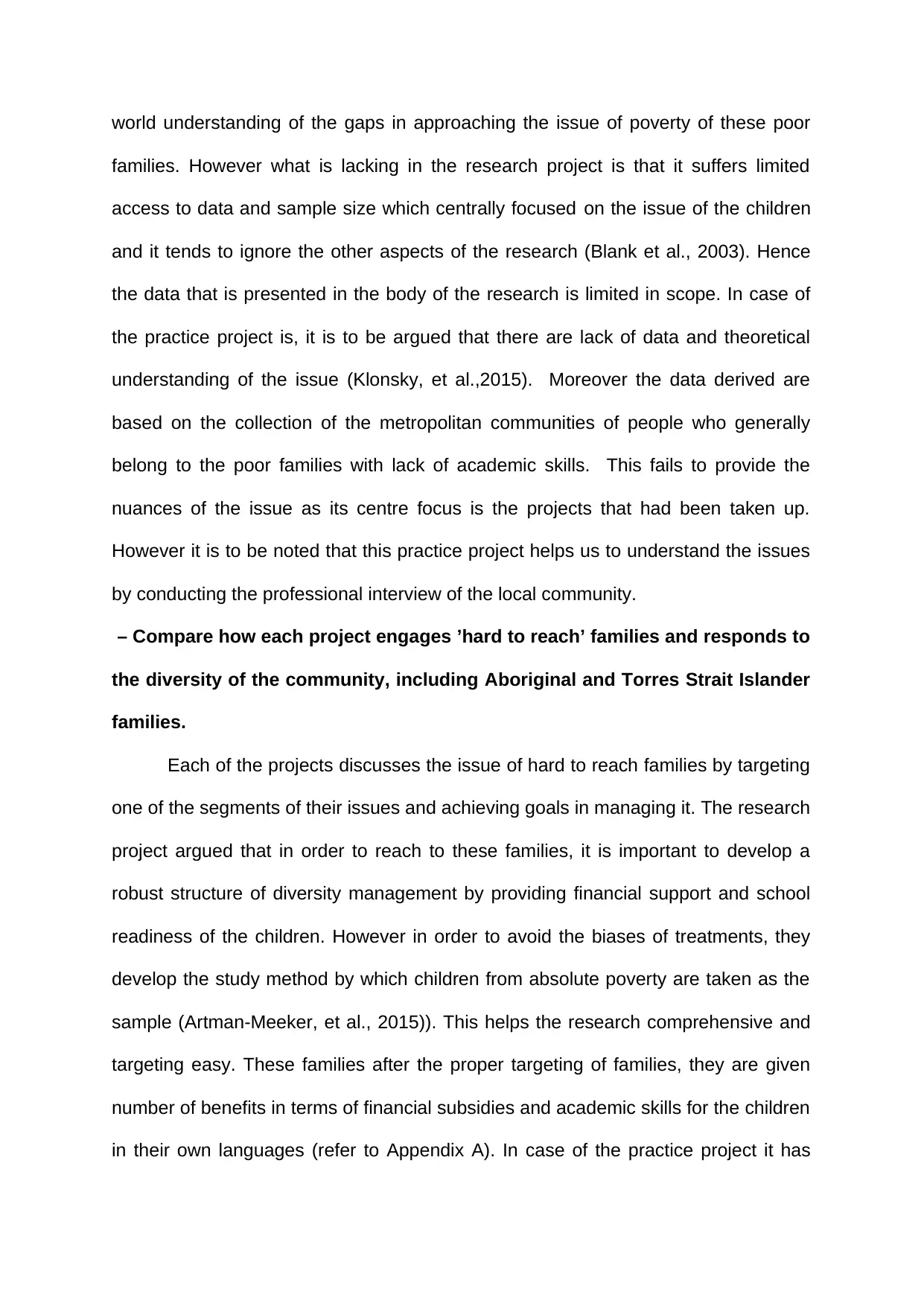
world understanding of the gaps in approaching the issue of poverty of these poor
families. However what is lacking in the research project is that it suffers limited
access to data and sample size which centrally focused on the issue of the children
and it tends to ignore the other aspects of the research (Blank et al., 2003). Hence
the data that is presented in the body of the research is limited in scope. In case of
the practice project is, it is to be argued that there are lack of data and theoretical
understanding of the issue (Klonsky, et al.,2015). Moreover the data derived are
based on the collection of the metropolitan communities of people who generally
belong to the poor families with lack of academic skills. This fails to provide the
nuances of the issue as its centre focus is the projects that had been taken up.
However it is to be noted that this practice project helps us to understand the issues
by conducting the professional interview of the local community.
– Compare how each project engages ’hard to reach’ families and responds to
the diversity of the community, including Aboriginal and Torres Strait Islander
families.
Each of the projects discusses the issue of hard to reach families by targeting
one of the segments of their issues and achieving goals in managing it. The research
project argued that in order to reach to these families, it is important to develop a
robust structure of diversity management by providing financial support and school
readiness of the children. However in order to avoid the biases of treatments, they
develop the study method by which children from absolute poverty are taken as the
sample (Artman-Meeker, et al., 2015)). This helps the research comprehensive and
targeting easy. These families after the proper targeting of families, they are given
number of benefits in terms of financial subsidies and academic skills for the children
in their own languages (refer to Appendix A). In case of the practice project it has
families. However what is lacking in the research project is that it suffers limited
access to data and sample size which centrally focused on the issue of the children
and it tends to ignore the other aspects of the research (Blank et al., 2003). Hence
the data that is presented in the body of the research is limited in scope. In case of
the practice project is, it is to be argued that there are lack of data and theoretical
understanding of the issue (Klonsky, et al.,2015). Moreover the data derived are
based on the collection of the metropolitan communities of people who generally
belong to the poor families with lack of academic skills. This fails to provide the
nuances of the issue as its centre focus is the projects that had been taken up.
However it is to be noted that this practice project helps us to understand the issues
by conducting the professional interview of the local community.
– Compare how each project engages ’hard to reach’ families and responds to
the diversity of the community, including Aboriginal and Torres Strait Islander
families.
Each of the projects discusses the issue of hard to reach families by targeting
one of the segments of their issues and achieving goals in managing it. The research
project argued that in order to reach to these families, it is important to develop a
robust structure of diversity management by providing financial support and school
readiness of the children. However in order to avoid the biases of treatments, they
develop the study method by which children from absolute poverty are taken as the
sample (Artman-Meeker, et al., 2015)). This helps the research comprehensive and
targeting easy. These families after the proper targeting of families, they are given
number of benefits in terms of financial subsidies and academic skills for the children
in their own languages (refer to Appendix A). In case of the practice project it has

been observed that there are number of promotion for the aboriginal groups and
getting their families engaged through different Medias. It is done with social media
and other platforms, the aboriginal children and their families are engaged in the
process of development since this helps to provide the opportunity for catering to the
needs of the people from diverse background.
Implications
Children who are exposed to hazardous conditions are victim of various
health hazards. Children at young age exposed to unhealthy situation develops a
poor sense immunity and also get influence by the larger ecological changes. In
order to learn and develop a proper sense of academic skills the child need to have
enough self-autonomy. When the child is in a vulnerable situation, he or she will not
be able to cope with the risk and challenges. Thus, the impact on the children is
multiplicative rather than additive. Children who will fare less will automatically will
exposed to adverse situation rather than the children who will receive a combination
of circumstances.
Deprived of warmth in the family, good parent-child bonding, presence of
family cohesion, extreme level of parental self-esteem are the possible factor of child
neglect and abuse (Irwin et al., 2010). Protective factors for children are parental
resilience, which refers to the parent’s capacity for resilience towards any kind of
stress or risk. Growing social connection can really be helpful because they work as
providing collective consciousness. Education and getting information about the child
development behaviours can promote healthy condition for the child. In order to avert
these risk factor, community awareness take precedence because if community
takes the responsibility of making people aware of such changes then development
will occur in a participatory manner.
getting their families engaged through different Medias. It is done with social media
and other platforms, the aboriginal children and their families are engaged in the
process of development since this helps to provide the opportunity for catering to the
needs of the people from diverse background.
Implications
Children who are exposed to hazardous conditions are victim of various
health hazards. Children at young age exposed to unhealthy situation develops a
poor sense immunity and also get influence by the larger ecological changes. In
order to learn and develop a proper sense of academic skills the child need to have
enough self-autonomy. When the child is in a vulnerable situation, he or she will not
be able to cope with the risk and challenges. Thus, the impact on the children is
multiplicative rather than additive. Children who will fare less will automatically will
exposed to adverse situation rather than the children who will receive a combination
of circumstances.
Deprived of warmth in the family, good parent-child bonding, presence of
family cohesion, extreme level of parental self-esteem are the possible factor of child
neglect and abuse (Irwin et al., 2010). Protective factors for children are parental
resilience, which refers to the parent’s capacity for resilience towards any kind of
stress or risk. Growing social connection can really be helpful because they work as
providing collective consciousness. Education and getting information about the child
development behaviours can promote healthy condition for the child. In order to avert
these risk factor, community awareness take precedence because if community
takes the responsibility of making people aware of such changes then development
will occur in a participatory manner.
⊘ This is a preview!⊘
Do you want full access?
Subscribe today to unlock all pages.

Trusted by 1+ million students worldwide
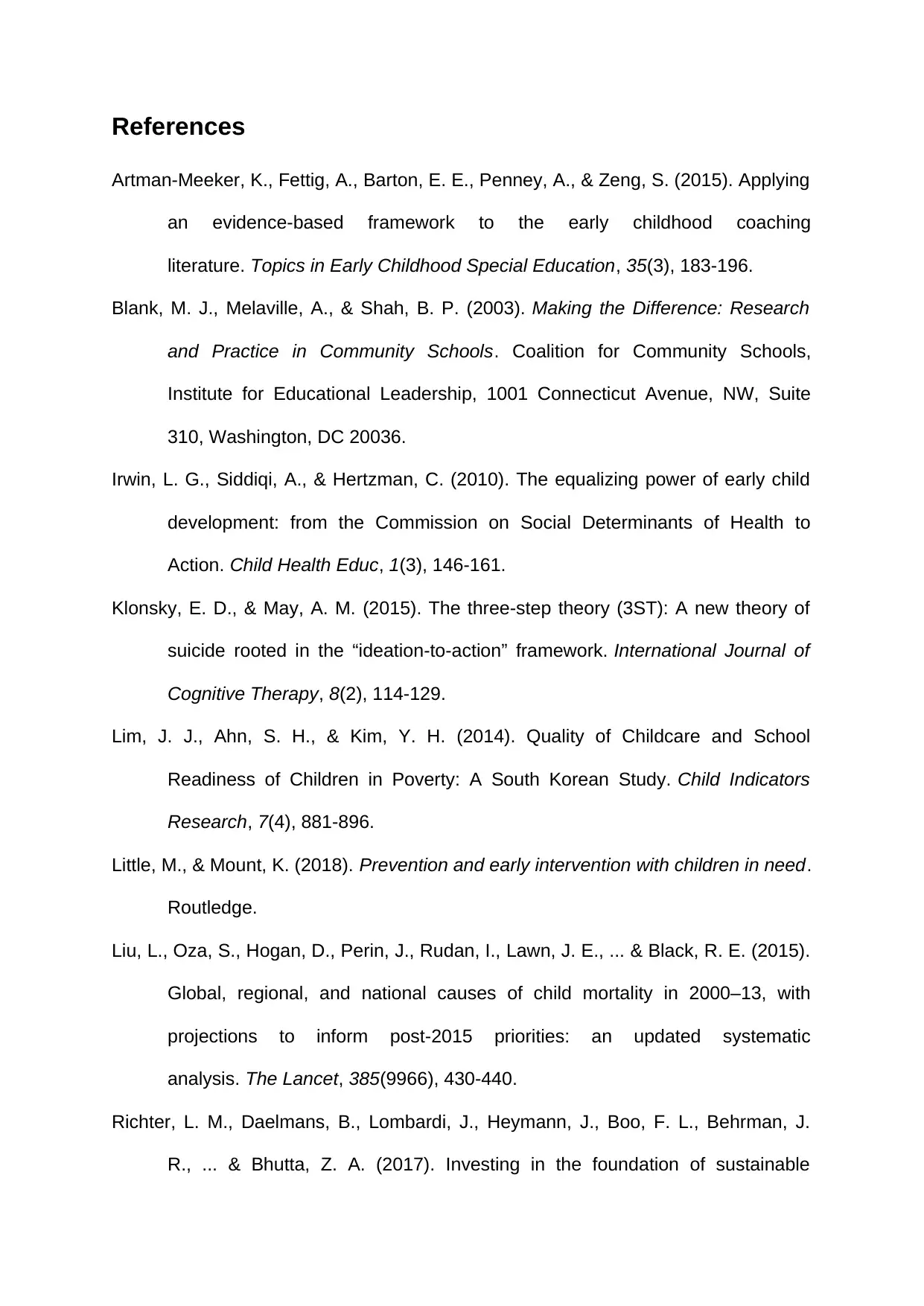
References
Artman-Meeker, K., Fettig, A., Barton, E. E., Penney, A., & Zeng, S. (2015). Applying
an evidence-based framework to the early childhood coaching
literature. Topics in Early Childhood Special Education, 35(3), 183-196.
Blank, M. J., Melaville, A., & Shah, B. P. (2003). Making the Difference: Research
and Practice in Community Schools. Coalition for Community Schools,
Institute for Educational Leadership, 1001 Connecticut Avenue, NW, Suite
310, Washington, DC 20036.
Irwin, L. G., Siddiqi, A., & Hertzman, C. (2010). The equalizing power of early child
development: from the Commission on Social Determinants of Health to
Action. Child Health Educ, 1(3), 146-161.
Klonsky, E. D., & May, A. M. (2015). The three-step theory (3ST): A new theory of
suicide rooted in the “ideation-to-action” framework. International Journal of
Cognitive Therapy, 8(2), 114-129.
Lim, J. J., Ahn, S. H., & Kim, Y. H. (2014). Quality of Childcare and School
Readiness of Children in Poverty: A South Korean Study. Child Indicators
Research, 7(4), 881-896.
Little, M., & Mount, K. (2018). Prevention and early intervention with children in need.
Routledge.
Liu, L., Oza, S., Hogan, D., Perin, J., Rudan, I., Lawn, J. E., ... & Black, R. E. (2015).
Global, regional, and national causes of child mortality in 2000–13, with
projections to inform post-2015 priorities: an updated systematic
analysis. The Lancet, 385(9966), 430-440.
Richter, L. M., Daelmans, B., Lombardi, J., Heymann, J., Boo, F. L., Behrman, J.
R., ... & Bhutta, Z. A. (2017). Investing in the foundation of sustainable
Artman-Meeker, K., Fettig, A., Barton, E. E., Penney, A., & Zeng, S. (2015). Applying
an evidence-based framework to the early childhood coaching
literature. Topics in Early Childhood Special Education, 35(3), 183-196.
Blank, M. J., Melaville, A., & Shah, B. P. (2003). Making the Difference: Research
and Practice in Community Schools. Coalition for Community Schools,
Institute for Educational Leadership, 1001 Connecticut Avenue, NW, Suite
310, Washington, DC 20036.
Irwin, L. G., Siddiqi, A., & Hertzman, C. (2010). The equalizing power of early child
development: from the Commission on Social Determinants of Health to
Action. Child Health Educ, 1(3), 146-161.
Klonsky, E. D., & May, A. M. (2015). The three-step theory (3ST): A new theory of
suicide rooted in the “ideation-to-action” framework. International Journal of
Cognitive Therapy, 8(2), 114-129.
Lim, J. J., Ahn, S. H., & Kim, Y. H. (2014). Quality of Childcare and School
Readiness of Children in Poverty: A South Korean Study. Child Indicators
Research, 7(4), 881-896.
Little, M., & Mount, K. (2018). Prevention and early intervention with children in need.
Routledge.
Liu, L., Oza, S., Hogan, D., Perin, J., Rudan, I., Lawn, J. E., ... & Black, R. E. (2015).
Global, regional, and national causes of child mortality in 2000–13, with
projections to inform post-2015 priorities: an updated systematic
analysis. The Lancet, 385(9966), 430-440.
Richter, L. M., Daelmans, B., Lombardi, J., Heymann, J., Boo, F. L., Behrman, J.
R., ... & Bhutta, Z. A. (2017). Investing in the foundation of sustainable
Paraphrase This Document
Need a fresh take? Get an instant paraphrase of this document with our AI Paraphraser
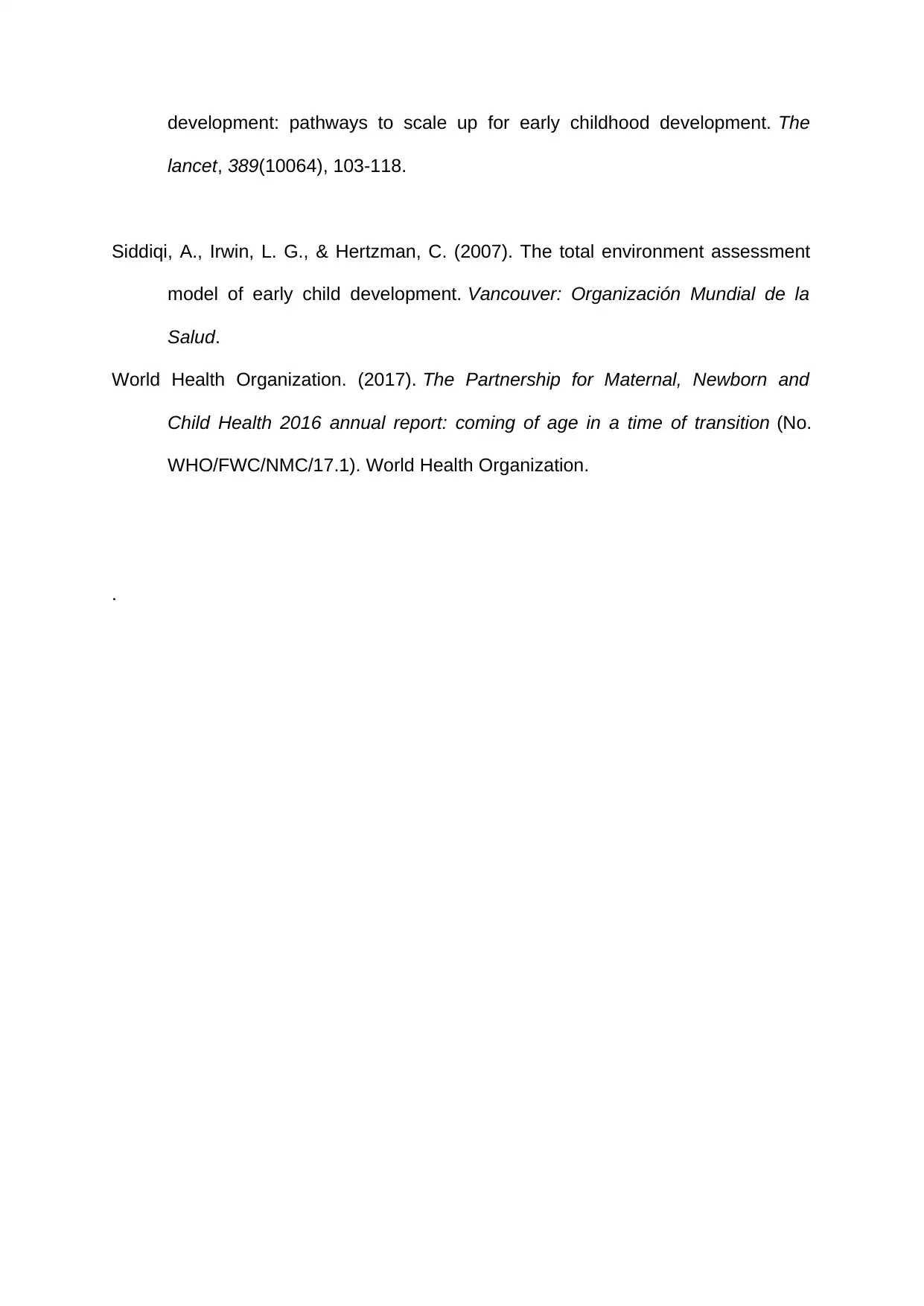
development: pathways to scale up for early childhood development. The
lancet, 389(10064), 103-118.
Siddiqi, A., Irwin, L. G., & Hertzman, C. (2007). The total environment assessment
model of early child development. Vancouver: Organización Mundial de la
Salud.
World Health Organization. (2017). The Partnership for Maternal, Newborn and
Child Health 2016 annual report: coming of age in a time of transition (No.
WHO/FWC/NMC/17.1). World Health Organization.
.
lancet, 389(10064), 103-118.
Siddiqi, A., Irwin, L. G., & Hertzman, C. (2007). The total environment assessment
model of early child development. Vancouver: Organización Mundial de la
Salud.
World Health Organization. (2017). The Partnership for Maternal, Newborn and
Child Health 2016 annual report: coming of age in a time of transition (No.
WHO/FWC/NMC/17.1). World Health Organization.
.
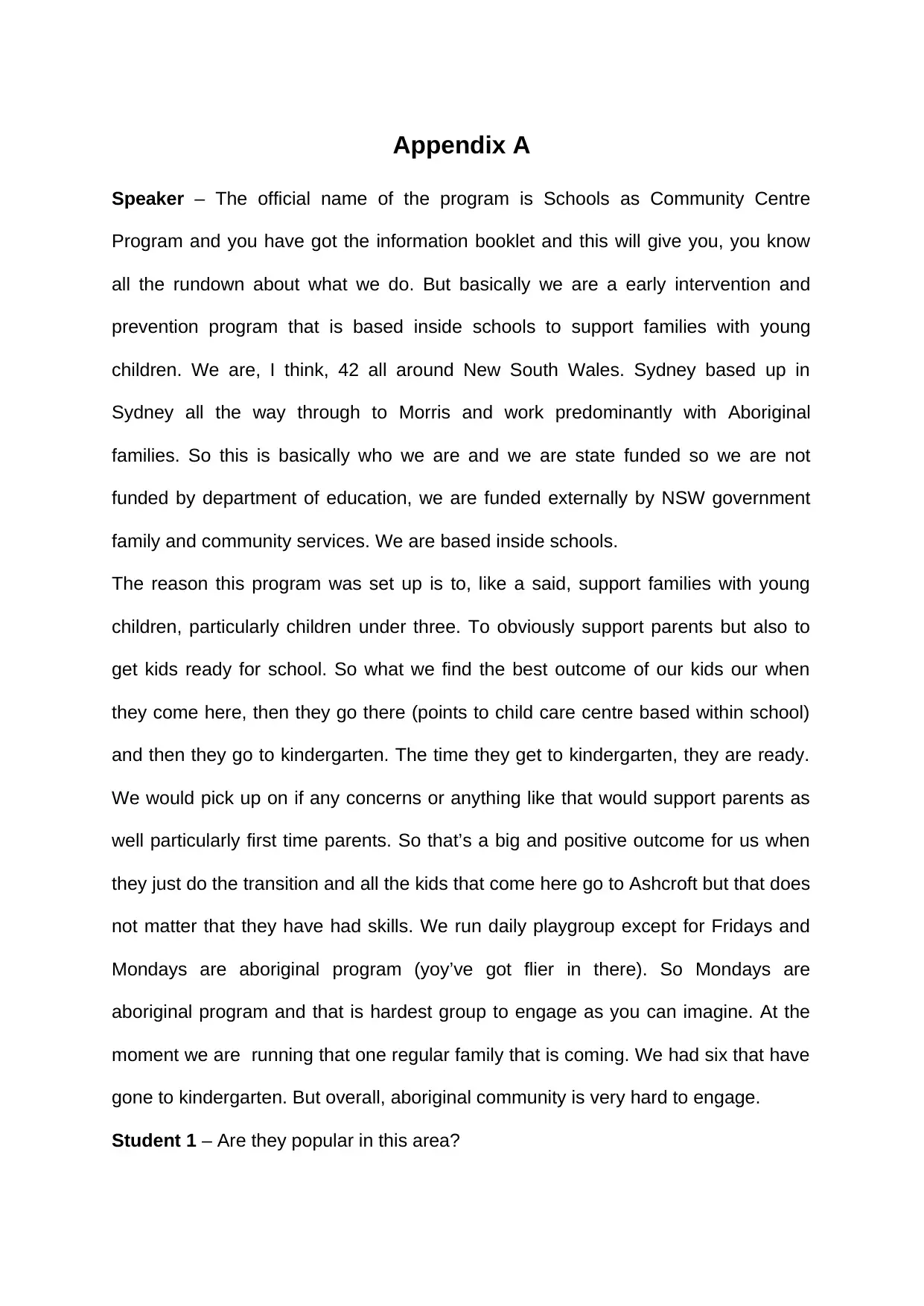
Appendix A
Speaker – The official name of the program is Schools as Community Centre
Program and you have got the information booklet and this will give you, you know
all the rundown about what we do. But basically we are a early intervention and
prevention program that is based inside schools to support families with young
children. We are, I think, 42 all around New South Wales. Sydney based up in
Sydney all the way through to Morris and work predominantly with Aboriginal
families. So this is basically who we are and we are state funded so we are not
funded by department of education, we are funded externally by NSW government
family and community services. We are based inside schools.
The reason this program was set up is to, like a said, support families with young
children, particularly children under three. To obviously support parents but also to
get kids ready for school. So what we find the best outcome of our kids our when
they come here, then they go there (points to child care centre based within school)
and then they go to kindergarten. The time they get to kindergarten, they are ready.
We would pick up on if any concerns or anything like that would support parents as
well particularly first time parents. So that’s a big and positive outcome for us when
they just do the transition and all the kids that come here go to Ashcroft but that does
not matter that they have had skills. We run daily playgroup except for Fridays and
Mondays are aboriginal program (yoy’ve got flier in there). So Mondays are
aboriginal program and that is hardest group to engage as you can imagine. At the
moment we are running that one regular family that is coming. We had six that have
gone to kindergarten. But overall, aboriginal community is very hard to engage.
Student 1 – Are they popular in this area?
Speaker – The official name of the program is Schools as Community Centre
Program and you have got the information booklet and this will give you, you know
all the rundown about what we do. But basically we are a early intervention and
prevention program that is based inside schools to support families with young
children. We are, I think, 42 all around New South Wales. Sydney based up in
Sydney all the way through to Morris and work predominantly with Aboriginal
families. So this is basically who we are and we are state funded so we are not
funded by department of education, we are funded externally by NSW government
family and community services. We are based inside schools.
The reason this program was set up is to, like a said, support families with young
children, particularly children under three. To obviously support parents but also to
get kids ready for school. So what we find the best outcome of our kids our when
they come here, then they go there (points to child care centre based within school)
and then they go to kindergarten. The time they get to kindergarten, they are ready.
We would pick up on if any concerns or anything like that would support parents as
well particularly first time parents. So that’s a big and positive outcome for us when
they just do the transition and all the kids that come here go to Ashcroft but that does
not matter that they have had skills. We run daily playgroup except for Fridays and
Mondays are aboriginal program (yoy’ve got flier in there). So Mondays are
aboriginal program and that is hardest group to engage as you can imagine. At the
moment we are running that one regular family that is coming. We had six that have
gone to kindergarten. But overall, aboriginal community is very hard to engage.
Student 1 – Are they popular in this area?
⊘ This is a preview!⊘
Do you want full access?
Subscribe today to unlock all pages.

Trusted by 1+ million students worldwide
1 out of 23
Related Documents
Your All-in-One AI-Powered Toolkit for Academic Success.
+13062052269
info@desklib.com
Available 24*7 on WhatsApp / Email
![[object Object]](/_next/static/media/star-bottom.7253800d.svg)
Unlock your academic potential
Copyright © 2020–2025 A2Z Services. All Rights Reserved. Developed and managed by ZUCOL.





